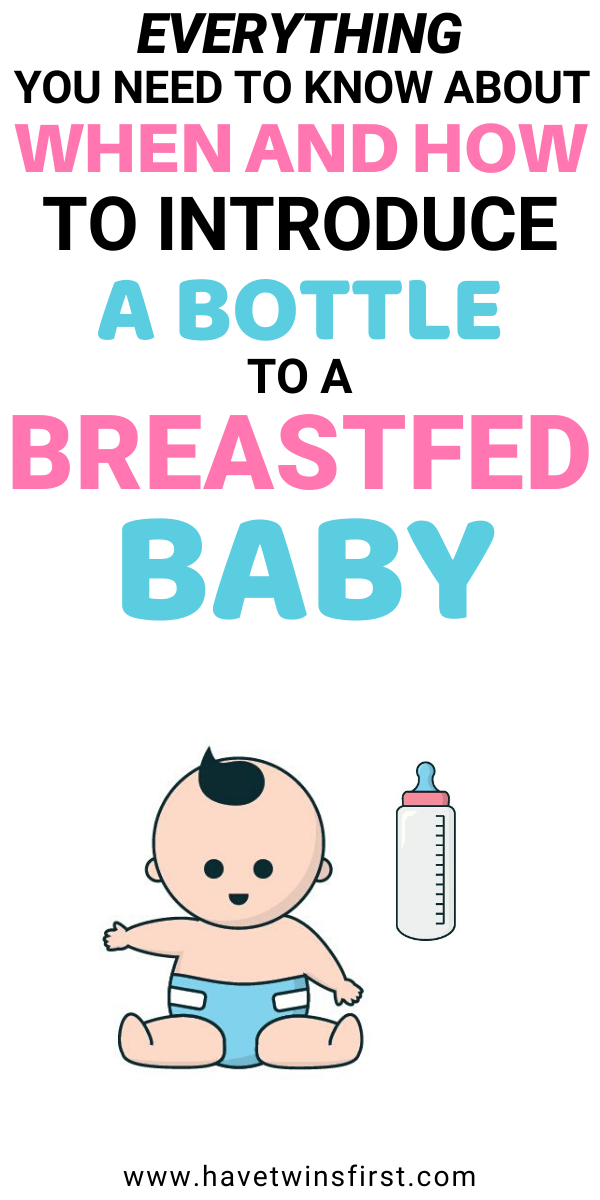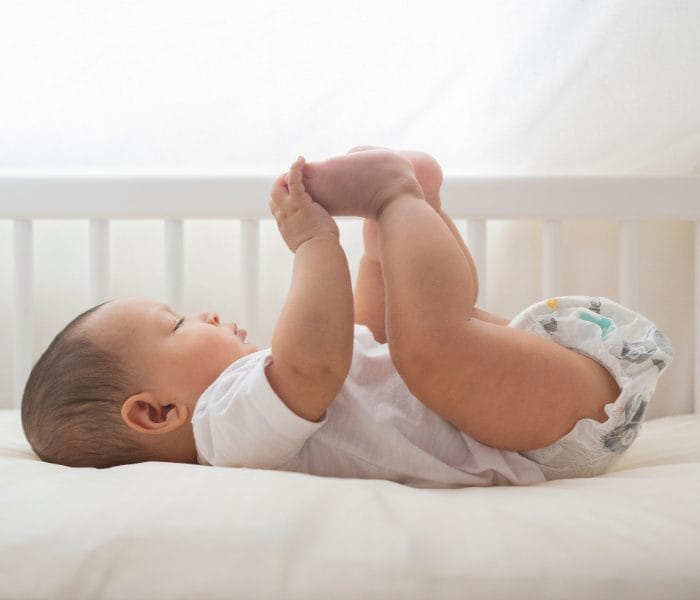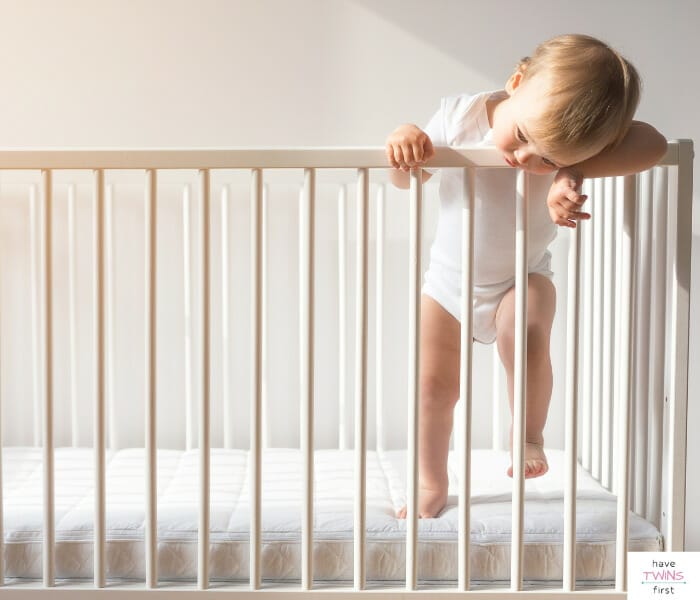As a mom who exclusively pumped and formula fed my twins, I was very unsure of when to introduce a bottle to my third breastfed baby.
The driving force behind introducing a bottle to my breastfed baby was that I knew I would eventually be pumping at work. It was critical to me to make sure he would take a bottle, but also still be able to nurse.
You might also be interested in introducing a bottle to your breastfed baby if you are thinking about combining breastfeeding and formula feeding or you want to prepare bottles for night feeds.
For combination breastfeeding and formula feeding, the first bottle should be only breast milk. But you can slowly transition to a mixture of formula and breast milk.
In this post I will first discuss when to introduce a bottle to a breastfed baby. I will also be reviewing how to combine pumping and breastfeeding and how much breast milk you can expect your baby to drink per feeding. Lastly, I have included a step by step list for successfully feeding bottles to your breastfed baby.
Please note, there are affiliate links in this post. Read my privacy & disclosure policy at the bottom of this page to learn more.
Age To Introduce Bottle To Breastfed Baby
What is the ideal time to introduce a bottle to a breastfed baby?
The key to this question is you do not want to wait too long to introduce a bottle, but you also do not want to introduce a bottle too early. If you wait too long to introduce your baby to a bottle, she might refuse it altogether. On the other hand, if you introduce it too early, your baby might not want to nurse anymore.
Basically, you don’t want your baby to get too comfortable with nursing and you don’t want your baby to get too comfortable with a bottle.
In the end, this means the ideal time to introduce a bottle to your breastfed baby is between 4 weeks and 8 weeks.
By 4 weeks, your baby should be getting the hang of nursing. And after 8 weeks you are risking your baby getting too comfortable with nursing and not wanting to try out a bottle.
How To Coordinate Pumping For Bottle Feeding
Now that you know when to introduce a bottle to a breastfed baby, you need to know about pumping. To get started feeding your baby a bottle, you will need to have some expressed breast milk for your baby to eat.
You could pump right before it’s normally time for your baby to eat. Or if you have already started building up a stash of breast milk, you can use that.
Keep in mind, you will want to pump anytime your baby eats and you are not there to nurse him. If you don’t pump when a nursing session is missed, your supply will decrease.
This means it might be easier to pump right before your baby eats, since you will not have to go through the process of warming up breast milk. On the other hand, if bottle feeding does not go smoothly you could wait to pump, in case you end up needing to breastfeed.
If the bottle feed goes well, pump after your baby is done drinking from the bottle. So, it’s your choice mama. I would just pick the option you feel most comfortable with.
For more information on what a pumping and breastfeeding schedule looks like and logs for tracking your progress check out these Pumping & Breastfeeding printables. They are perfect for working pumping moms or anyone who plans to do combine pumping and breastfeeding together.
How Much Breast Milk Per Feeding?
A big question breastfeeding moms have is how much breast milk their baby will drink per feeding. Since you have been nursing, you don’t know how much milk to expect your baby will need to drink.
Luckily, you can use this handy dandy breast milk per bottle calculator. This will give you a good estimate on what to expect your baby might drink.
For example, a 6 week old will have about 3 oz of breast milk per feeding.
Which Bottle Should Be Used?
As far as which bottle to use for breast milk. I recommend starting with bottles that are compatible with your breast pump.
For example, I used a Medela breast pump, so I started by feeding my baby with a Medela bottle. Luckily, my little guy was happy to drink from this bottle.
It could be useful to have a few other bottle brands on hand. If you don’t want to buy them ahead of time, you could wait and look into buying them if the first bottle feed doesn’t go well.
A helpful tip, is that Dr. Brown’s bottles are compatible with a Medela pump. You can buy a conversion kit for Philips Avent bottles. I know this because I used these bottles when I pumped for my twins.
If there are other bottle brands you interested in, I recommend researching their compatibility with the breast pump you use. It can save you valuable time in the future.

How To Prepare A Breast Milk Bottle
Next, we need to review the proper steps for preparing a bottle of breast milk for feeding. The first thing to be aware of is to prevent bubbles. Bubbles could cause your baby some stomach pains if she has trouble burping.
The most likely way to get bubbles in breast milk is by shaking the bottle. If the breast milk has been stored, it will separate. The layer on top is the fat from the milk.
If your breast milk has separated, it will be necessary to mix it back together. To do this swirl the bottle, rather than shaking it, to mix it up. Let the bottle sit for a few minutes to let the bubbles dissipate.
Additionally, if you are using breast milk from the fridge or freezer it will likely need to be warmed up a bit. I always tried feeding my kids breast milk straight from the fridge, but I never had any luck getting them to drink it. As long as it was just slightly warmed, they would drink the breast milk.
To warm a bottle of breast milk, we filled a pint glass with hot tap water. The tap water needs to be as hot as possible from the sink.
Next put the bottle in the pint glass for about 2 minutes. It is useful to swirl the bottle a few times while it’s being warmed up. This always did the trick for us and all three of our babies would drink breast milk after warming it this way.
Who Should Feed First Bottle Of Breast Milk?
One of the most important things about feeding the first few bottles is that mom SHOULD NOT be the one to give the bottle.
In fact, the breastfeeding mom should not even be in the room during the feed. Your baby could get distracted with you there. Also, even just your smell could cause your baby to reject the bottle.
So as hard as it is for mom, she will need to leave the room for the feeding. Have dad, a caregiver, or another family member attempt feeding the first bottle.
I recommend continuing to have someone other than mom feed your baby a bottle for the first 3-5 feedings. A perk for breastfeeding moms on this – you get a break for once, yay!
Proper Bottle Feeding Technique
All right now the bottle has been prepared and it’s time to feed your baby. The person feeding your baby will want to have a burp cloth handy. Additionally, you will want to try this feeding when your baby is hungry, but not starving.
If your baby usually eats every 2-3 hours, then try to give him the bottle about 1.5 hours after the last feed. The person doing the feeding will hold the baby at a slight incline, with his head slightly elevated.
When it’s time to give the bottle, start by squeezing the nipple onto the baby’s mouth, so a couple drops of milk comes out. This will give the signal to your baby that it’s time to eat and he will taste the breast milk he is used to drinking.
Hopefully after this, the feeder can move forward with feeding the bottle. The bottle should be fed 1/3 at a time. After 1/3 is gone, give the baby a break and burp him. Burp again after each additional third has been eaten by the baby.
It’s also good to feed the bottle one third at a time, to slow down the feed. A baby can eat faster from a bottle when compared to nursing.
How To Introduce A Bottle Of Expressed Milk
Now that you know when to introduce a bottle to a breastfed baby and all the steps you need to take to give the bottle. I thought it would be very helpful to summarize all this information in a list.
- Introduce a bottle to a breastfed baby at 4 weeks to 8 weeks old.
- For any nursing feedings that are missed, a pumping session will be needed to maintain breast milk supply.
- Use this calculator to figure out how much breast milk to expect your baby to eat in a feeding.
- Try to use a bottle that is compatible with your breast pump.
- Swirl the breast milk bottle to make sure it is well mixed and warm it up.
- The person feeding the first bottle to a breastfed baby should NOT be mom.
- Be sure to keep baby’s head slightly elevated while bottle feeding.
- Feed the bottle one third at a time and burp baby after each third has been eaten.
Need Pumping Help?
Before I go, I want to share some really helpful pumping info for those moms that will be feeding breast milk from a bottle.
If you are concerned or are not happy with your breast milk production from pumping there are some really wonderful online pumping classes that can really help you maximize your breast milk supply.
Milkology offers a wide variety of breastfeeding and pumping classes that cater to your needs. Whether you want to learn how to maximize your pumping sessions at work or you just need help pumping more milk, these classes are a wonderful choice.
So, if you need a little boost with pumping or breastfeeding, check it out. They are very reasonably priced. And, it is totally worth it for the peace of mind that you are comfortable with your pumping (or breastfeeding) plan. The best choices for pumping moms related to this article are listed below.
- Back To Work Pumping Class
- Pump It Up! (how to increase your milk supply when pumping)
I hope this post has helped you to understand both when and how to feed your breastfed baby a bottle for the first time. Good luck mama, you got this.








The bottle warmer will make your life easier because it makes warming up formula or breast milk extremely easy and quick.